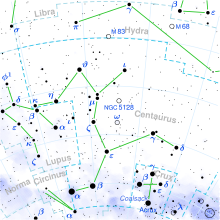| Alpha Centaurids | |
|---|---|
 Celestial map of Centaurus | |
| Discovery date | 1969 |
| Parent body | Unknown |
| Radiant | |
| Constellation | Centaurus |
| Right ascension | 14h 00m 00s |
| Declination | −10° 00′ 00″ |
| Properties | |
| Occurs during | January 28 to February 21[1] |
| Date of peak | February 8 |
| Velocity | 58 km/s km/s |
| Zenithal hourly rate | 6[1] |
The Alpha Centaurids are a meteor shower in the constellation Centaurus, peaking in early February each year. The average magnitude is around 2.5, with a peak of about three meteors an hour.[2]
They have been observed since 1969, with a single possible recorded observation in 1938.[3]
References
- ^ a b Kronk, Gary W. (October 10, 2013). Meteor Showers, An Annotated Catalog. Springer New York. p. 50. ISBN 9781461478973.
- ^ Lunsford, Robert (2009). Meteors and how to Observe Them. Springer. p. 74. ISBN 978-0-387-09460-1.
- ^ Kronk, Gary W. "The Alpha and Beta Centaurids". Meteor Showers Online. Archived from the original on 2007-11-30.

